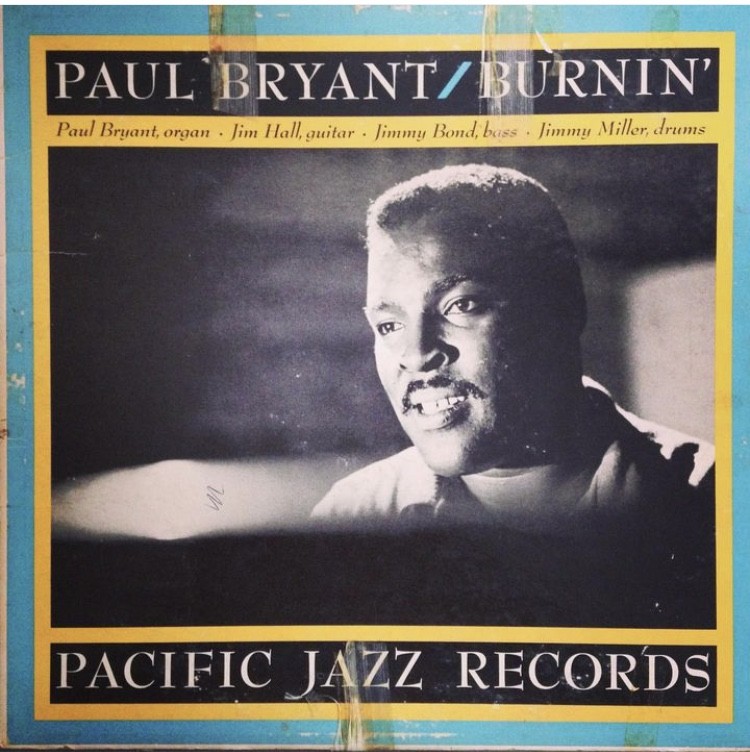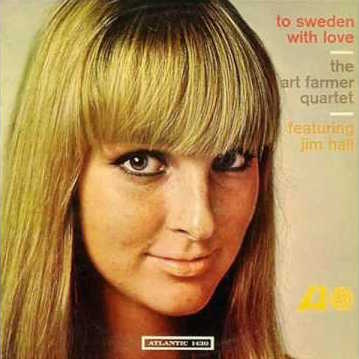Come on baby, light my fire.

Personnel
Paul Bryant (organ), Jim Hall (guitar), Jimmy Bond (bass), Jimmy Miller (drums)
Recorded
in 1960 in Los Angeles
Released
as PJ-12 in 1960
Track listing
Side A: Still Searching / Love Nest / Blues At The Summit / Side B: They Can’t Take That Away From Me / Searchin’ / The Masquerade Is Over / Burnin’
Patrons loved organ combos, which usually, following the example of pioneers Wild Bill Davis and Jimmy Smith, made do with bass pedals and thus without an upright bass player. One less musician on the payroll. Most organists were from the East and Mid-West. Jimmy Smith, Jimmy McGriff, Richard “Groove” Holmes, Trudy Pitts, Shirley Scott, Big John Patton, Gene Ludwig, Brother Jack McDuff and Lonnie Smith.
Paul Bryant hailed from Ashbury Park, New Jersey, but is known as a West Coast cat. That’s because Bryant lived there from an early age. The liner notes to this record and others offer no way of explanation as to when and why he ended up in California, but elsewhere, on the world wide web, it is said that he came to California with his mother at a young age. The notes give us concise but valuable information about a rather obscure musician. In the words of Johnny Magnus:
“For more than 20 years of his 27 years, organist Paul Bryant has been in show business. He appeared, while still very young, in the famous Our Gang Comedy series, and has since worked in numerous motion pictures and television productions. Paul studied piano for 16 years before deciding on music as a career. During his senior year at Jefferson High School in Los Angeles, Paul joined the dance band that included alto saxophonist Frank Morgan, trumpeter Art Farmer, drummer Ed Thighpen and reedman Buddy Collette. When the Korean War broke out, Bryant enlisted in the Air Force, where for the next five years he played piano in a 16-piece dance band as part of a Special Services unit. During this time he expanded his musical knowledge by studying writing and arranging. After being discharged from the service in 1956, Paul worked in the Los Angeles area as a pianist until 1958 when he decided to study organ and was promptly hired by tenorman Claude McClinn.”
Bryant formed an organ combo at about the same time as the most notable organ migrant to the West Coast scene, Richard “Groove” Holmes. Richard Bock from Pacific Jazz coupled Bryant with tenor saxophonist Curtis Amy, a combination that garnered plenty attention and left a legacy of two albums: The Blues Message (1960) and Meetin’ Here (1961).
Bryant also played on Johnny Griffin’s album on Riverside, Grab This. (I’ve been thinking, this might’ve been through his connection with the recently deceased drummer Doug Sides, a Los Angeles native)
Unlike Richard “Groove” Holmes, though Bryant played around the country now and then, he didn’t break through nor recorded prolifically. He passed away in Los Angeles in 2010, leaving us, luckily, with a bunch of grooving goodies. He’s got a deep groove and plays firmly in the pocket. An attention grabber not only by sermonizing eloquently, he plays the odd be bop phrase as well as employs nice harmonic sequences, no doubt as a result of his proficiency as a piano player.
All this is in evidence on Burnin’, which offers gritty blues (Still Searchin’, Blues At The Summit, Burnin’), gospel (Churchin’) and standards (Love Nest, The Masquerade Is Over and They Can’t Take That Away From Me). The solid rhythm section of Jimmy Bond and Jimmy Miller is complemented with (making this The Three Jimmy’s) guitarist Jim Hall, as subtle and eloquent as they come. A very interesting addition indeed!
A year later, some black musicians, critics and fans criticized Sonny Rollins for enlisting ‘whitey’ Hall for his all-black outfit on his famous comeback album The Bridge after a three-year hiatus. Here, in 1960, he’s the only Caucasian cat in a band of Afro-American colleagues. Went totally unnoticed.
But that’s another story. The story of Bryant the underboss on the B3 is well-worth pursuing.
Listen to Burnin’ on YouTube below:





